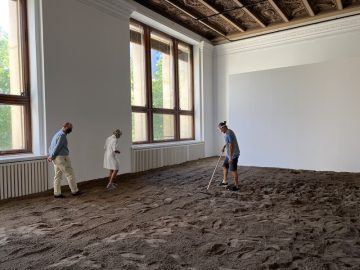Hannah Carroll Harris in Berlin Art Link:
 Asad Raza’s expansive cross-disciplinary practice defies categorization. Situated somewhere between performance, installation and curation, its elusiveness can be attributed to many factors. Primary to these is the fact that Raza’s work rejects the rigid prescriptiveness that these disciplines often demand. Rather, his open-ended, site-specific installations supply fertile ground for interaction, ideas and communities to develop. In his piece ‘Absorption’, currently on view at Gropius Bau as part of ‘Down to Earth’, this is quite literally the case. Twenty tons of artificial neosoil have been installed within the gallery space, cared for by a team of “cultivators” who tend to the soil, raking it, testing its PH levels and gifting it to visitors to nurture their own gardens. Here, both the soil and its cultivators act as a conduit for conversation and community.
Asad Raza’s expansive cross-disciplinary practice defies categorization. Situated somewhere between performance, installation and curation, its elusiveness can be attributed to many factors. Primary to these is the fact that Raza’s work rejects the rigid prescriptiveness that these disciplines often demand. Rather, his open-ended, site-specific installations supply fertile ground for interaction, ideas and communities to develop. In his piece ‘Absorption’, currently on view at Gropius Bau as part of ‘Down to Earth’, this is quite literally the case. Twenty tons of artificial neosoil have been installed within the gallery space, cared for by a team of “cultivators” who tend to the soil, raking it, testing its PH levels and gifting it to visitors to nurture their own gardens. Here, both the soil and its cultivators act as a conduit for conversation and community.
With a background in film-making, Raza composes situations in which to explore our relations with non-human living beings, and each other, with a view to thinking about how we can foster new ways of approaching and caring for these relationships. Whether through a fully-functioning tennis court installed in a 16th Century Milanese church; 26 young flowering trees and their caretakers at the Whitney Biennial; or tons of artificial soil in Sydney and Berlin, his works far exceed the bounds of the walls in which they are situated. We spoke to Raza about this radiating effect, the role of agency and new ways of thinking about care and kinship in the creative community.
More here.
